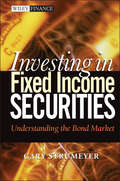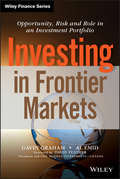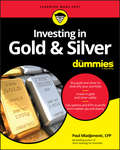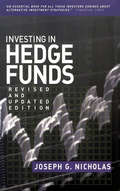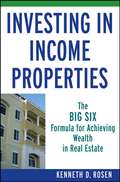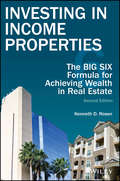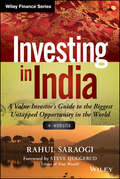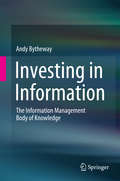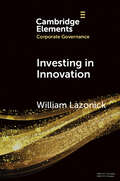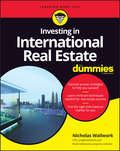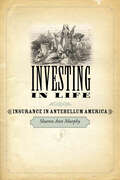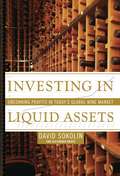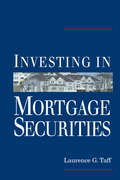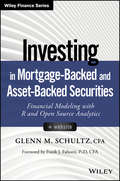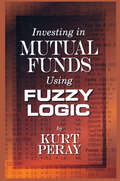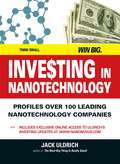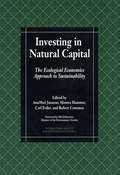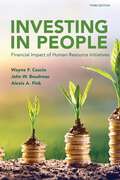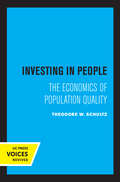- Table View
- List View
Investing in Fixed Income Securities
by Gary StrumeyerInvestors who've primarily purchased equity securities in the past have been looking for more secure investment alternatives; namely, fixed income securities. This book demystifies the sometimes daunting fixed income market, through a user-friendly, sophisticated, yet not overly mathematical format. Investing in Fixed Income Securities covers a wide range of topics, including the different types of fixed income securities, their characteristics, the strategies necessary to manage a diversified portfolio, bond pricing concepts, and more, so you can make the most informed investment decisions possible.
Investing in Frontier Markets
by Gavin Graham Al Emid David FeatherThe only comprehensive guide to reaping big returns investing in the hottest new growth marketsThis book makes a compelling case that, just as today's well-rounded portfolio includes emerging market funds, tomorrow's well-rounded portfolio will include frontier market funds. More importantly, it alerts you to the vast opportunities and potential pitfalls of investing in frontier markets while providing expert advice and guidance on how to research and invest in the most promising frontier growth markets. Widely considered to be the next emerging markets, frontier markets, such as those of certain sub-Saharan African, Eastern European, Asian, and Central and South American countries, are showing strong signs of reaching economic critical mass. If you are an investor on the lookout for authoritative, actionable information on the next big investment opportunity, this book is for you.Provides sector-by-sector analyses that let you assess opportunities and risks in each frontier marketProvides strategies and tools for determining the most efficient methods for executing, monitoring, and exiting investmentsGuides you through the wide diversity within frontier markets, showing how to differentiate countries on the basis of economic development and wealth distribution and other factors
Investing in Gold & Silver For Dummies
by Paul MladjenovicDiversify your portfolio with gold and silver Investing and trading in gold and silver is always a sound idea—and that goes double in a time of unusual market fluctuation. As people look for safe places to diversify their investment risk, you’ll likely see the value of your investment go up where other stocks are vulnerable. Gold and silver saw increases in value of 16% and 15% respectively in 2019—putting them among the top ten most desirable commodities out there—and are projected to experience even more of a bear market as the dollar wobbles in an uncertain post-COVID world. This year, 2020, gold and silver are set up to have their best year of price appreciation over the past 40+ years. Written in an easy-to-follow, no-jargon style by CFP and bestselling author, Paul Mladjenovic, Investing in Gold & Silver For Dummies explains the different complex processes and vehicles for buying gold and silver. You’ll find out the best ways to add these to your portfolio, how to balance risk and reward, and how to adapt time-tested investing plans and strategies to your goals. Identify your goals and form a plan Buy gold and silver safely to diversify your portfolio Use ETFs and options to profit from market ups and downs Understand when a gold and silver investment is legitimate Use technical analysis to time your market entries Whatever your current familiarity with gold and silver, this book gives you the extra expert knowledge you need navigate your gold and silver investment portfolio safely through a bear or bull market.
Investing in Hedge Funds: Strategies For The New Marketplace (Bloomberg Financial #51)
by Joseph G. NicholasHedge funds are in the news and on the minds of sophisticated investors more than ever. Investors have questions about how the funds are structured, where the assets are allocated, and whether hedge funds can truly act as a hedge against market risk. The answers are all here in Investing in Hedge Funds. Until recently, much of what makes hedge funds tick has been closely guarded--the intellectual property of Wall Street's investment elite. In this updated and revised text, Joseph G. Nicholas, founder and chairman of the leading industry information provider Hedge Fund Research, Inc., travels inside the hedge fund marketplace to explain the alternative investment strategies of top fund managers, providing clear descriptions of how to access these funds and where they're headed. It's a complete guide that everyone investing in hedge funds should study closely.
Investing in Human Capital
by Miguel Palacios LlerasThis study recommends employing "human capital contracts" wherein students agree to pay a percentage of their income over time in exchange for funds to finance their education. The main difference between "human capital contracts" and loans is the variable value of the payments students make during the repayment period. Their financial consequences, of risk transfer from students to investors and increased information regarding future graduates' earnings, make the contracts an attractive alternative in funding higher education.
Investing in Income Properties
by Kenneth D. RosenPraise for INVESTING IN INCOME PROPERTIES"Investing in Income Properties is a cogent and well organized presentation of the principles of real estate analysis, financing, and investment. With his 'Big Six Formula,' Ken Rosen shares his knowledge and experiences on how to analyze and take advantage of commercial real estate investment opportunities. This book should be required reading in all real estate investment courses."--John S. Zdanowicz, PhD, Professor, Finance and Real Estate, and Director of the Jerome Bain Real Estate Institute, Florida International University"Ken Rosen has a unique ability to make the most complicated seem clear and easy to follow. In Investing in Income Properties, he gives practical steps so that the reader can take action and begin or continue to build wealth by investing in income properties. This book will become the buyer's bible."--Alex Zylberglait, Associate Director, National Office and Industrial Properties Group, Marcus & Millichap Real Estate Investment Services"Investing in Income Properties is a step-by-step approach to investing in commercial real estate. It is clear, easy reading with every base covered. This book is a great tool for both the new and seasoned investor."--Donna Abood, Chief Executive Officer, Colliers Abood Wood-Fay, Commercial Real Estate"Ken Rosen's style is straightforward and his formula for building wealth is well grounded in the fundamentals--nothing fancy or tricky about it! He even puts the would-be investor at ease by addressing the fear factors of real estate investing. Twenty-one years into my career as a real estate investment sales broker, I have met many successful investors, but Ken Rosen clearly stands out as a savvy, self-made entrepreneurial investor who is generously sharing his wealth of knowledge and insight in this very instructive and easy-to-read book."--David L. Meline, Executive Director, Capital Markets Group, Investment Sales Specialist, Cushman & Wakefield of Georgia Inc."One of the best, precise, and accurate real estate books on the market. A must-read for investors at any stage."--Scott K. Sime, Managing Director, CB Richard Ellis Brokerage, Miami-Dade County
Investing in Income Properties: The Big Six Formula for Achieving Wealth in Real Estate
by Kenneth D. RosenKen Rosen argues that successful real estate investors do not get rich in an up market. They get rich and stay rich by investing in real estate for the long-run. And, in fact, they view market downturns as opportunities. Part I in Investing in Income Properties reviews the basics of real estate and how to get started. It also identifies the key players on a winning investment team. Then Part II explains how to obtain the cash resources to begin investing in winning income producing properties by using the author’s unique Big Six formula. These chapters show how to structure deals with the most leverage and extraordinary rates of return. The third part of the book underscores the money to be made in buying and selling homes and condos while offering strategies for picking up properties below market value. The final section of the book tells how to convert apartments, office buildings and warehouses into condominiums, as well as how to recognize opportunities offered by vacant land.
Investing in India
by Rahul SaraogiA practical, real-world guide to investing in IndiaIndia's rapid economic growth offers obvious opportunities for foreign investors, but making wise investing decisions can be difficult for any investor without a deep knowledge of the country and its culture. With a vibrant democracy and an active press, India can be a complex and chaotic place in which investors can find it difficult to make investing decisions with confidence. This book offers an on-the-ground perspective on India from one of India's most successful value investors. Looking deeply into the internal realities that impact India's investment climate, Investing in India helps investors both inside and outside the country cut through the noise and find the facts that truly matter for anyone who wants to invest there.Features charts of stocks, markets, and other helpful Indian economic indicatorsOffers a real-world look at India's politics and governance; its financial system and capital markets; its asset classes and equity markets; the private equity scene; and the real estate marketWritten by Indian value investing guru Rahul Saraogi
Investing in Information
by Andy BythewayThis book gathers together, in a new way, established and contemporary thinking about how to get the best out of information technology and information systems investments. Working managers who are beset by the complexities of information management in the age of Big Data and the Social Web, and students who are trying to make sense of information management in a chaotic world that is more and more driven by the Internet, will all benefit from this new treatment of a long-standing and problematic domain. Importantly, the book reveals and clarifies the dependencies that exist between the inner world of information technology and the outer world of people and organisations at work. The book differs from other books in its reflective approach. It avoids lengthy, descriptive, and prescriptive dogma. Rather, it provides tools for thinking about information management and it identifies strategic and tactical options at six levels: from the simple consideration of information technology and information systems, right through to issues of organisational performance and business strategy. At the heart of the matter are two critical and tightly connected issues: the ways that we conceive and manage an organisation's processes, and the ways that we conceive and manage the information that an organisation needs to sustain those processes. The six-level framework that achieves this clarity is the "Information Management Body of Knowledge" (familiarly known as the "IMBOK"). This easy-to-understand and easy-to-remember framework has been found to be extremely useful in business, in government, in civil society and in education. Throughout the book, selected research papers are identified and summarised. There are also summary chapters from three different operational perspectives: performance and competency assessment using the IMBOK, undertaking research into related issues, and a review of parallel expert thinking. This book stands as a reference point and resource for all those who need to straddle the disparate worlds of "information technology" and "business". It provides firm pedagogical foundations for courses dealing with business management in the information age, and it provides a sound reference framework for researchers who need to position research projects related to information technology and information systems in a wider context. For busy managers, who simply wish to identify, understand and successfully manage information technology-related opportunities, it provides an ideal arrangement of ideas and tools that will help them.
Investing in Innovation: Confronting Predatory Value Extraction in the U.S. Corporation (Elements in Corporate Governance)
by William LazonickBusiness corporations interact with household units and government agencies to make investments in productive capabilities required to generate innovative goods and services. When they work harmoniously, these three types of organizations constitute 'the investment triad'. The Biden administration's Build Back Better agenda to restore sustainable prosperity in the United States has focused on investment in productive capabilities by government agencies and household units. Largely absent from the Biden agenda have been policy initiatives to ensure that, given government and household investment in productive capabilities, the governance of major U.S. business corporations supports investment in innovation. This Element explains how corporate financialization, manifested by predatory value extraction in the name of 'maximizing shareholder value', undermines investment in innovation in the United States. It concludes by outlining a policy framework, beginning with a ban on stock buybacks, that confronts predatory value extraction and puts in place social institutions that support sustainable prosperity.
Investing in International Real Estate For Dummies
by WallworkAspiring international real estate investors—expand your portfolio today! The real estate world can be a particularly difficult place to do business, and this book helps aspiring international investors of all skill levels avoid some of the pitfalls first-timers often make. Expert author Nicholas Wallwork opens your eyes to how accessible international real estate can be and provides an excellent introduction to some of the main strategies and nuances when investing at home or away. Investing in International Real Estate For Dummies covers expert strategies for investing in international real estate, going beyond the more obvious tactics like buy-to-lease and flipping houses. It gives you a solid roadmap for successful property investing that actually works in any market. It lays out checklists of tasks and offers step-by-step guidance and advice based on over a decade of in-the-trenches experience working in the international real estate investment sector. Learn previously unseen expert strategies Find out how to choose which countries to invest in Easily navigate your way around lease options Build an in-country network of reliable contacts Manage your new assets with ease How to build the mindset of a top real estate investor Looking to start or expand your international real estate portfolio? Everything you need is at your fingertips!
Investing in Knowledge Workers' Networks and Learning
by Thomas H. DavenportTechnical and social approaches to improving knowledge creation and sharing complement each other, but they emanate from preconceived notions of how knowledge workers get information and solve problems at work. While knowledge worker performance is critical, we know little about how high performers within that category get information and knowledge from other workers. This chapter evaluates how knowledge workers find and use information, detailing research conducted to provide a ground-level view of high performing knowledge workers. This chapter is excerpted from "Thinking for a Living: How to Get Better Performance and Results from Knowledge Workers."
Investing in Life: Insurance in Antebellum America (Studies in Early American Economy and Society from the Library Company of Philadelphia)
by Sharon Ann MurphyWinner, Hagley Prize in Business History, Hagley Museum and Library and the Business History ConferenceInvesting in Life considers the creation and expansion of the American life insurance industry from its early origins in the 1810s through the 1860s and examines how its growth paralleled and influenced the emergence of the middle class.Using the economic instability of the period as her backdrop, Sharon Ann Murphy also analyzes changing roles for women; the attempts to adapt slavery to an urban, industrialized setting; the rise of statistical thinking; and efforts to regulate the business environment. Her research directly challenges the conclusions of previous scholars who have dismissed the importance of the earliest industry innovators while exaggerating clerical opposition to life insurance.Murphy examines insurance as both a business and a social phenomenon. She looks at how insurance companies positioned themselves within the marketplace, calculated risks associated with disease, intemperance, occupational hazard, and war, and battled fraud, murder, and suicide. She also discusses the role of consumers—their reasons for purchasing life insurance, their perceptions of the industry, and how their desires and demands shaped the ultimate product.
Investing in Life: Insurance in Antebellum America (Studies in Early American Economy and Society from the Library Company of Philadelphia)
by Sharon Ann MurphyA study of the early years of the life insurance industry in 19th century America.Investing in Life considers the creation and expansion of the American life insurance industry from its early origins in the 1810s through the 1860s and examines how its growth paralleled and influenced the emergence of the middle class.Using the economic instability of the period as her backdrop, Sharon Ann Murphy also analyzes changing roles for women; the attempts to adapt slavery to an urban, industrialized setting; the rise of statistical thinking; and efforts to regulate the business environment. Her research directly challenges the conclusions of previous scholars who have dismissed the importance of the earliest industry innovators while exaggerating clerical opposition to life insurance.Murphy examines insurance as both a business and a social phenomenon. She looks at how insurance companies positioned themselves within the marketplace, calculated risks associated with disease, intemperance, occupational hazard, and war, and battled fraud, murder, and suicide. She also discusses the role of consumers?their reasons for purchasing life insurance, their perceptions of the industry, and how their desires and demands shaped the ultimate product.Winner, Hagley Prize in Business History, Hagley Museum and Library and the Business History ConferencePraise for Investing in Life“A well-written, well-argued book that makes a number of important contributions to the history of business and capitalism in antebellum America.” —Sean H. Vanatta, Common Place“An intriguing, instructive history of the establishment and development of the life insurance industry that reveals a good deal about changing social and commercial conditions in antebellum America . . . Highly recommended.” —Choice
Investing in Liquid Assets: Uncorking Profits in Today's Global Wine Market
by David Sokolin Alexandra BruceNow more than ever, the value of Investment-Grade Wines (IGWs) and opportunities to invest in wine as an asset class are soaring. With a little research and a little risk, wine enthusiasts on every level will find it possible to gain big rewards in wine investment -- and there's never been a better time to try. IGWs have dependably outperformed blue chip stocks over the past 150 years, and the upscale wine market is still an area in which independent investors can profit handsomely. A third-generation wine merchant, and CEO of one of the largest rare-wine companies in the world, David Sokolin knows how to turn fine wine into cold cash. And he knows how you can, too. In simple, practical terms, Investing in Liquid Assets provides all the information you need to understand the economic principles that govern the world of fine wine and take advantage of the resources currently available. Using his insider's expertise, Sokolin defines Investment-Grade Wine and identifies the most financially important wine regions and styles. Defining the key players in the field, Sokolin shows you how to navigate the world of wine critics and understand the impact of their scores, and he explains why it's perfectly fine that your own personal tastes really don't matter. He offers tips on where to find reputable sources for fine wine, how to manage storage and resale, as well as all-important buying and selling strategies. In the second half of the book, he gives overviews of the world's greatest wine regions and offers his predictions about which regions and which wines are likely to represent the greatest investment opportunities in the near future. Providing information and tactics previously known only to successful professionals, Investing in Liquid Assets turns your passion for fine wine into a valuable resource that will pay for itself.
Investing in Mortgage Securities
by Laurence G. TaffProviding the expertise of an internal business consultant to one of the largest issuers of mortgage securities, Investing in Mortgage Securities serves as a high-level introduction to mortgage securities presented within the framework of fixed income securities. It presents institutional investors, portfolio managers, traders, and sophisticated in
Investing in Mortgage-Backed and Asset-Backed Securities: Financial Modeling with R and Open Source Analytics (Wiley Finance)
by Glenn M. SchultzA complete guide to investing in and managing a portfolio of mortgage- and asset-backed securities Mortgage- and asset-backed securities are not as complex as they might seem. In fact, all of the information, financial models, and software needed to successfully invest in and manage a portfolio of these securities are available to the investment professional through open source software. Investing in Mortgage and Asset-Backed Securities + Website shows you how to achieve this goal. The book draws entirely on publicly available data and open source software to construct a complete analytic framework for investing in these securities. The analytic models used throughout the book either exist in the quantlib library, as an R package, or are programmed in R and incorporated into the analytic framework used. Examines the valuation of fixed-income securities—metrics, valuation framework, and return analysis Covers residential mortgage-backed securities—security cash flow, mortgage dollar roll, adjustable rate mortgages, and private label MBS Discusses prepayment modeling and the valuation of mortgage credit Presents mortgage-backed securities valuation techniques—pass-through valuation and interest rate models Engaging and informative, this book skillfully shows you how to build, rather than buy, models and proprietary analytical platforms that will allow you to invest in mortgage- and asset-backed securities.
Investing in Mutual Funds Using Fuzzy Logic
by Kurt PerayFuzzy Logic is an analytical tool used in the modeling of those phenomena that fall outside the scope of exact sciences. It is used in the analysis of complex and highly nonlinear processes, where mathematical models or standard classic logic cannot define conditions inherent to such processes, e.g. human thinking.Kurt Peray's detailed analysis of the new approaches and techniques for Risk Control and Portfolio Asset Allocation - which uses the principles of Fuzzy Logic - helps you to make decisions as to when to buy, hold or sell. While making independent and educated decisions, you will be able to hedge your portfolio from the volatile forces in the market, and will offset the erosive impact of inflation and taxation.In this electronic age, investors have quick access to important information relevant to the decision process. The guidelines and formulas that serve as foundations to the Fuzzy Logic approach gives you the ability to build customized programs. Investing in Mutual Funds Using Fuzzy Logic is for the individual who wants to invest in financial instruments that will provide a return for growth. With the investment approach he devised, Peray guides the you towards achieving your investment goals.
Investing in Nanotechnology: Think Small, Win Big
by Jack UldrichAlthough nanotechnology deals with the very small--the art and science of manipulating and rearranging individual molecules to create useful materials, devices, and systems--its impact on business will be very big. Within a decade, nanotechnology should account for $1 trillion worth of products in the United States alone. This groundbreaking book provides you with the steps you MUST take to assess and profit from the nanotech market; relevant information on more than 100 leading public and private nanotech companies; how to distinguish the real players from the "nano-pretenders"; a comprehensive methodology for prudently investing in--and profiting from--nanotechnology in a way that yields market-beating returns while minimizing risk; and more!
Investing in Natural Capital: The Ecological Economics Approach To Sustainability (Intl Society for Ecological Economics)
by Carl Folke Robert Costanza Monica Hammer Annmari JanssonInvesting in Natural Capital presents the results of a workshop held following the second biannual conference of the International Society for Ecological Economics. It focuses on the relation of human development to natural capital, and the relation of natural capital to environmental processes.Because we are capable of understanding our impact on the environment and the importance of managing it sustainably, humans play a special role in our ecosystem. The book emphasizes the essential connections between natural ecosystems and human socioeconomic systems, and the importance of insuring that both remain resilient. Specific chapters deal with methodology, case material, and policy questions, and offer a thorough exploration of this provocative and important alternative to conventional economics.
Investing in Nature: The Nature Conservancy and NatureVest 2018
by Shawn Cole Caitlin Lindsay Reimers BrummeCase
Investing in One Lesson
by Mark SkousenWhy are the smartest, most successful professionals so often failures when it comes to investing? Can stock prices really be so illogical that even doctors and lawyers can't figure them out? Ultimately, is it possible for anyone to decipher the financial markets? Fortunately, the answer is yes. In Investing In One Lesson, investment guru Mark Skousen clearly and convincingly reveals the reasons for the seemingly perverse, unpredictable nature of the stock market. Drawing upon his decades of experience as an investment advisor, writer, and professor, Dr. Skousen explains in one spirited, easy-to-follow lesson why stock prices fluctuate with such apparent irrationality. Lifting back the veil of perplexity and confusion that surrounds the workings of the stock market.
Investing in Online Marketplaces
by Andrei Hagiu Hermes AlvarezSimon Rothman had recently been promoted from executive-in-residence to Partner at esteemed venture capital firm Greylock Partners and placed in charge of managing a $100 million early-stage fund commitment dedicated to online marketplaces. In Greylock's view, 2014 was a special moment in time for online marketplaces, the beginning of a boom in the space that was being catalyzed by mobile technology and social identity. Rothman was the right man for the job. An early eBay employee, he had founded eBay Motors and turned it into a multi-billion dollar business and also advised several successful online marketplaces such as Lyft, Wanelo and TaskRabbit. For his first investment as Partner, Rothman was particularly interested in the food delivery space, which was ripe for disruption by online marketplaces. Rothman had five food delivery startup options to choose from, a philosophy on how to analyze marketplace businesses, and a few weeks to make his first ever investment as a Partner at Greylock.
Investing in People: Financial Impact of Human Resource Initiatives
by Wayne F. Cascio John W. Boudreau Alexis A. FinkIn an era of heightened scrutiny, organizations must make smarter, more evidence-based decisions about investing in people. Investing in People equips HR professionals and leaders with a proven framework for aligning human capital initiatives with strategic business outcomes. Drawing on cutting-edge research from psychology, economics, finance and accounting, the book shows how to evaluate HR programs - such as talent acquisition, engagement and learning - using foundational principles like risk, return and scale. It also offers tools to connect HR initiatives to metrics that matter to senior leadership, including financial performance and customer satisfaction.With practical guidance for integrating HR into enterprise budgeting and strategy, this is an essential resource for building credibility and making HR decisions that drive results.
Investing in People: The Economics of Population Quality (The Royer Lectures)
by Theodore W. SchultzThis title is part of UC Press's Voices Revived program, which commemorates University of California Press’s mission to seek out and cultivate the brightest minds and give them voice, reach, and impact. Drawing on a backlist dating to 1893, Voices Revived makes high-quality, peer-reviewed scholarship accessible once again using print-on-demand technology. This title was originally published in 1981.
